TALE: A Possible Theme called “Theory-based Reflection”
Developing Unique Perspectives for Creative Works

The above picture was designed in January 2023. I have been using the term “Theory-based Reflection” many times. Today I had a micro conversation with a designer on Linkedin. The conversation inspires me to write this post with the “Theory-based Reflection” theme.
- Name: Theory-based Reflection
- Clue: Developing Unique Perspectives for Creative Works
- Type: knowledge theme
- Contributors: Juan J. Ramirez, Zeeshawn Durrani
- Reference: Expansive Activity Analysis, Strategic Thematic Exploration, Design as Creative Life
- Related Themes: Methodological Empathy, Perspectives on Product Engagement (v1.0), Possible Personas
The micro conversation concerns the designer’s ability to find customer signals with research and hard data in smaller companies.
Juan J. Ramirez published a post that lists a set of designers’ abilities on Linkedin.
Ability to produce high-quality visuals.
Ability to design reasonably usable experiences.
Ability to justify design decisions.
Ability to find customer signal with research and hard data.
Ability to collaborate effectively with engineers.
Ability to communicate with stakeholders.
Ability to explain how you add value.
I commented on the issue of design and research.
I have a question about #4 and #5
- (#4) Ability to find customer signal with research and hard data.
- (#5) Ability to collaborate effectively with engineers.Can we change #4 to “Ability to collaborate effectively with researchers”?
It may depend on the structure of teams. If Customer Research is not an independent function, then Designers have to handle this issue.
Juan’s reply:
Sure. But the appetite to hire researchers is at an all-time low. Companies are trying to compress job functions right now.
Zeeshawn Durrani shared his personal experience:
Always been a big challenge for me personally. Personally love research and hard data but hate the activity of conducting it. In smaller companies where you have no research function and have a bunch of other shit constantly thrown at you, it’s a super difficult one to get right.
I replied to Zeeshawn’s comment and mentioned the theme of “Theory-based Reflection”:
Zeeshawn Durrani It seems that there is a business opportunity for solving this problem.
I have been working on connecting THEORY with PRACTICE for three years. My primary theoretical resources are Activity Theory, Ecological Psychology, and other social practice theories.
Also, I have over ten years of experience in digital product design.
How do you want on dealing with this challenge? Do you want to learn theory-based reflection and develop your own perspectives? or just case-by-case theory-based analysis?
In fact, smaller companies really need strong research support because they need to make more creative decisions.
The theme of “Theory-based Reflection” can be understood from two perspectives.
From the perspective of Creative Life, we can encourage designers to adopt the “Theory-based Reflection” mindset for lifelong learning and life development.

You can find more details in [CALL] Design as Creative Life.
From the perspective of Product Engagement, we can encourage product decision-makers to adopt the “Theory-based Reflection” mindset for product development.
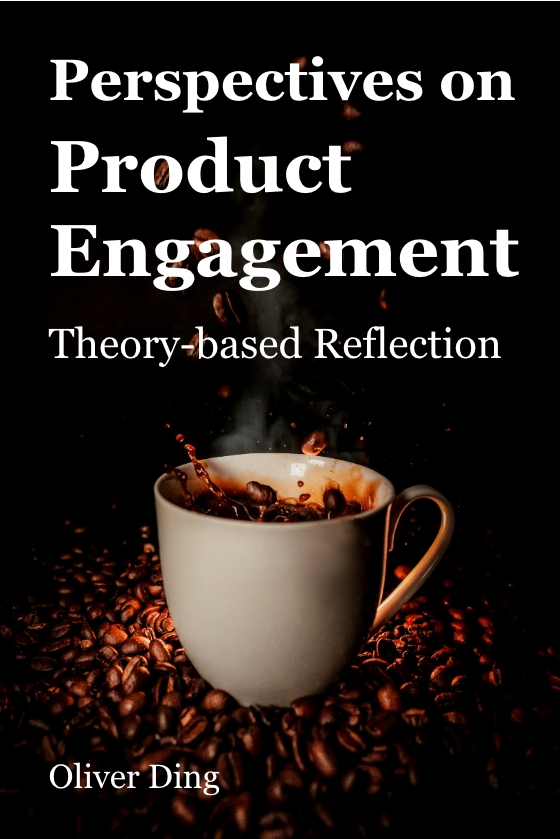
You can find more details in TALE: Perspectives on Product Engagement (v1.0).
Design, Research, and Decision Making
Some designer researchers tend to claim that research is a design activity. For example, Erika Hall @ Mule shared her view in A Design Research Framework:
When I say design research I mean asking and answering questions in a systematic way in order to make more intentional and informed decisions about planning and creating new things and ways of doing things.
Even when I’m talking about research that informs the design of interactive digital systems, I don’t say “UX research” or “user research.” Quite often, the decisions at hand have much wider implications and the information required crosses a variety of topics, including the organization and the design process itself.
Focusing on “the user” exclusively is an easy way to forget about the wider context around that user. And that’s how you get ants, and a lot of otherwise well-meaning designers participating in unsustainable and unethical businesses. Word choice matters. Design is the application of intention, and you are only as intentional as you are informed.
The word “research” contributes a lot of confusion because there are different types of research and different professional standards. Different standards turn into dueling standards in many organizations, which themselves have been poorly designed. There’s that lack of clarity and intention again. Misapplying an academic standard to professional research activities can block learning. Using research tools and practices without sufficient training and critical thinking can be downright dangerous.
I see design research as a design activity, more than a research activity. What matters most is learning what you need to know in order to make the best possible design decisions within existing constraints. It doesn’t necessarily matter if you uncover anything new, or whether you document what you learn in a specific format. It does matter that you are intentional, conscientious, and ethical at every step.
Let’s focus on smaller companies that don’t have research functions. From the perspective of Product Engagement, smaller companies should make the right product-centered decisions.
I don’t think the team should push all tasks about product-related research to designers. In fact, the CEO or the product lead should be the primary “researcher manager” of all product-related research activities.
The outcome of product-centered research activities should be useful for making the right product-centered decisions. It depends on the size and resources of companies, the research method can be diverse.

You can find more details in TALE: A Possible Theme Called “Methodological Empathy”.
Theory-based Reflection v.s. Practice-based Reflection
What’s the difference between Theory-based Reflection v.s. Practice-based Reflection?
A simple answer is that the former adopts theoretical concepts or frameworks to develop new insights while the latter only uses some simple cognitive heuristics to develop new insights.
In Platform Innovation as Concept-fit, I made an example of this type of distinction.
The diagram below is the outcome of a Practice-based Reflection.

The above diagram shows three types of Concept-fit:
- First fit: sociocultural concepts v.s. technological concepts (idea development)
- Second fit: concept v.s. exemplar (product development)
- Third fit: product v.s. culture (market development)
These three stages correspond to the stages of innovation: idea development, product development, and market development.
How did I develop it into a Theory-based framework? I adopted several theoretical frameworks as tools for elaborating the Concept-fit framework. The major theoretical resources are Project-oriented Activity Theory and the Ecological Practice approach.
The diagram below is one of the diagrams of the final framework.
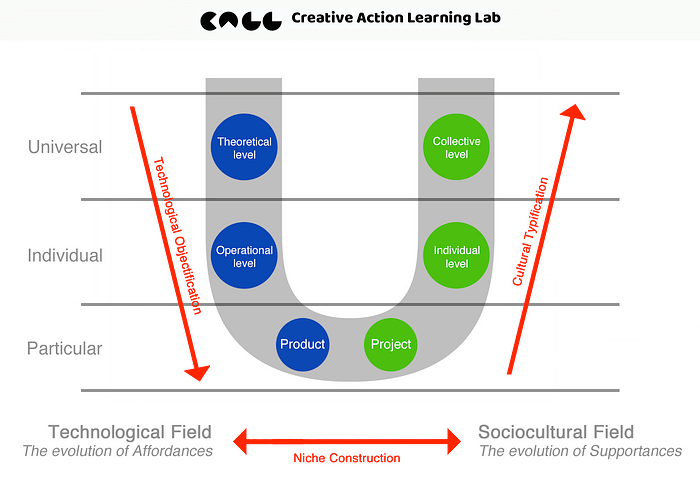
You can find more details in the original article.
Possible Creative Life
From the perspective of Creative Life, we can encourage designers to adopt the “Theory-based Reflection” mindset for lifelong learning and life development.
In a previous post titled TALE: A Possible Theme called “Possible Personas”, I encourage designers to think about their future career personas.
If a designer lists his/her top talents as the following skills, what are his/her possible personas?
- Creative Imagination
- Strategic Curation
- Digital Craftsmanship
- Ask Questions
- Structural Analysis
- Making Visual Metaphors
In order to answer the question, I made the following diagram.
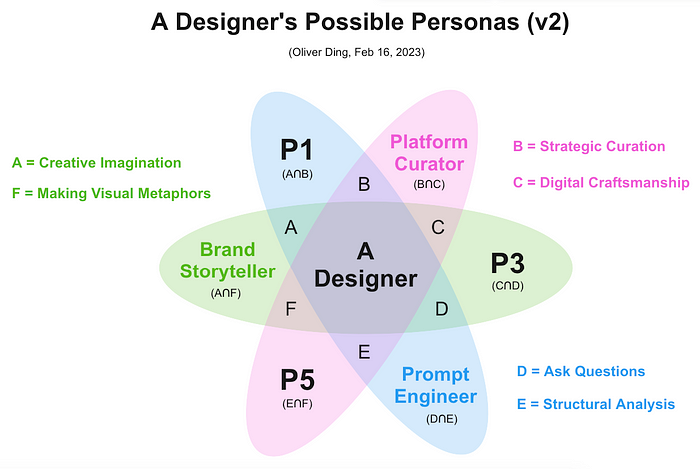
By using the above diagram, we can discover three possible personas:
- Prompt Engineer = Ask Questions + Structural Analysis
- Platform Curator = Strategic Curtion + Digital Craftsmanship
- Brand Storyteller = Creative Imagination + Making Visual Metaphors
Moreover, I developed the Persona Dynamics framework for further discussion.
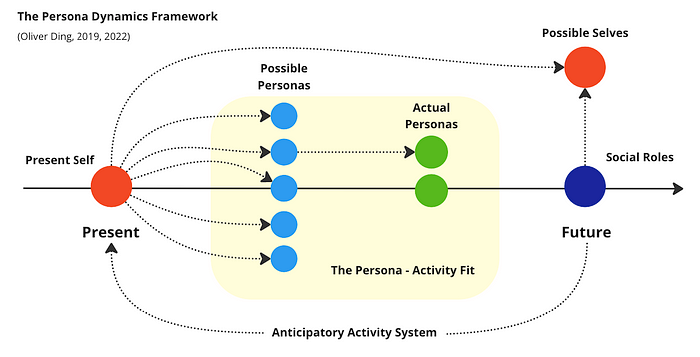
As mentioned above, there are many possible personas, but only some of them could be transformed into actual personas. The key to transformation is the Persona — Activity Fit.
Eventually, some actual personas could be transformed into social roles.
If a person thinks about his/her possible selves and decides to do something about one particular possible self, then this decision activates an Anticipatory Activity System.
The Anticipatory Activity System (AAS) framework is inspired by Activity Theory, Anticipatory System theory, Relevance theory, and other theoretical resources. The framework is about modeling a specific structure: “Self, Other, Present, Future”.
An Anticipatory Activity System is formed by two parts: First-order Activity and Second-order Activity.
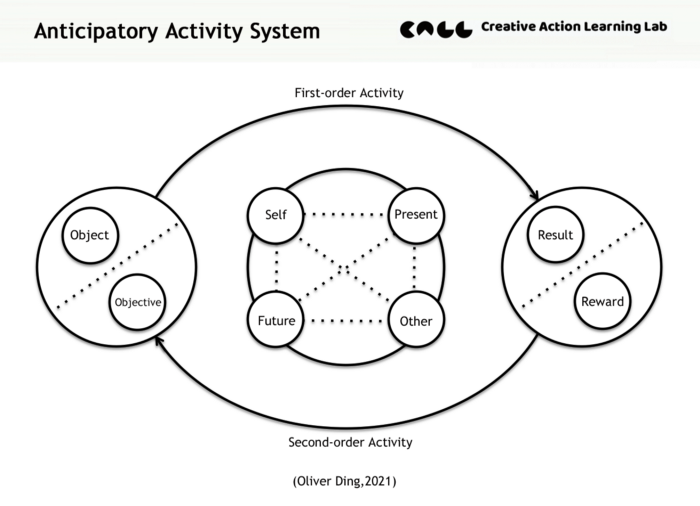
What’s the relationship between the Personas Dynamics Framework and the Anticipatory Activity System (AAS) framework?
As a new approach to Activity Theory, the Anticipatory Activity System (AAS) framework offers an abstract model for understanding future-oriented activities. It can be applied to domains such as Strategy Development, Career Development, Life Strategy, etc.
In 2022, I wrote a book (draft) titled Advanced Life Strategy: Anticipatory Activity System and Life Achievements. However, I didn’t discuss the “Self — Personas — Role” issue in the book.
I’d like to add the Personas Dynamics Framework to the Advanced Life Strategy toolkit. You can find more details in Life Strategy Center.
Update
Participative Strategy Development (PSD) and Self-Determination Theory — August 5, 2023
August 1, 2023, Jeroen Kraaijenbrink published an article titled Participative strategy development: A collaborative model for talent engagement on HRD Connect.
Participative strategy development leads to better strategy and smoother execution. But, did you know that it also has 3 key benefits for attracting and retaining talent?
In a time where attracting and retaining talent is arguably more difficult than attracting and retaining customers, organizations need all hands on deck to remain attractive as employers.
Participative strategizing can help. It means you involve more and different people earlier on in the strategy development process. Rather than merely the board or management team, you include people from throughout the organization. Crucially, do so not just in the execution phase, but right from the very start of the strategy development process.
Better strategy and smoother execution are sufficient reasons to replace a top-down approach with a participative approach to strategizing. From an HR perspective, though, there are even more reasons why you want such a participative approach. Three significant benefits stand out.
1. Making a contribution
A core driver of human behavior is the idea of doing something meaningful. Of making a contribution. A participative approach to strategizing directly taps into this. By involving people and genuinely asking them for their input, they experience that they matter beyond just doing their jobs. It shows you appreciate people above and beyond their specific skills, for who they are and what they think.
2. Learning and Development
Involving people in the strategy development process provides them with a context to grow. When being challenged to think about the strategically relevant aspects of their job, unit, or role, people learn to think more strategically beyond just the operational day-to-day work they do. Furthermore, in addition to this learning-by-doing aspect, a participative approach to strategy also works great with additional directed strategy training — at all levels.
3. Sense of Community
Participative strategy allows you to co-create strategy. When the leadership does not impose strategy on people, but codevelops it with and by them, it increases their people’s sense of belonging. After all, they have created the strategy together with their colleagues and managers. The strategy will also be less sensitive to silo-thinking, further enhancing the sense of community.
All three are strong drivers for people to join your organization and stay. Because, people want to make a contribution, they want to learn and develop, and they want a sense of community.
When will you start opening up the strategy process and involve your people?
The above diagram represents the Participative Strategy Development (PSD) model.
I made a comment on his Linkedin post about the model and connected it to Self-Determination Theory (SDT).

Thanks for sharing! I am working on connecting THEORY and PRACTICE. From my perspective, Participative Strategy Development (PSD) can connect to Self-Determination Theory.
Self-Determination Theory (SDT) is an established psychological theory about human motivation. SDT claims that there are three basic psychological needs for human beings.
1. Autonomy
“… participative strategizing requires you to involve more and different people earlier on in the strategy development process….”
For talent, PSD’s primary aspect is Autonomy.
2. Competence
“Learning and Development, Involving people in the strategy development process provides them with a context to grow….”
This is related to Competence.
3. Relatedness
“Sense of Community… When HR does not impose strategy on people, but codevelops it with and by them, it increases their people’s sense of belonging…”
Relatedness refers to “need to have a close, affectionate relationships with others”.
— — — -
“Making a contribution” could be understood under the intersection between “Competence” and “Autonomy”. If we combine these two basic needs together, one outcome is “Contribution”.

